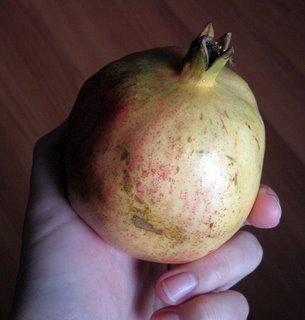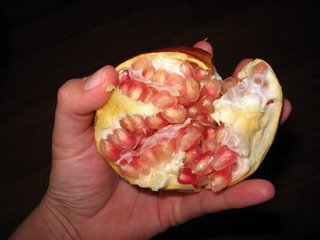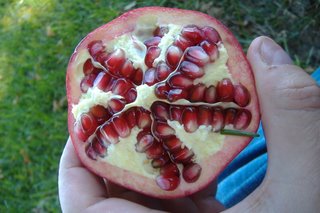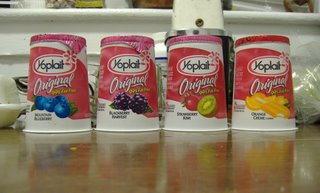
They sure do like their yoghurt around here. I noticed that right away. It took me longer to notice that the flavors are just--well, just a tiny bit different. Superficially they look the same. But actually they're not. You'd think, for example, that the one on the top left would be your standard mixed-berry. But on closer inspection, it proves to be strawberry-
mulberry! Emphasis on the mulberry. There are whole mulberries in there! (4 stars)
Then there's your corn yoghurt. Corn is a big hit around here. You can buy corn on the cob, already cooked, at any street-corner as well as shrink-wrapped in 7-11. You can buy popcorn in big bags from--somewhere. I haven't identified yet where, but have seen a lot of people with bags of popcorn. Corn on pizza is a standard. But corn in yoghurt, IMO, is going WAY too far. I bought the corn yoghurt just so I could take this picture. But then I had to eat it. I waited as long as I possibly could. When it was the last yoghurt left, I ate it. It was absolutely horrible. Not only did it have big corn kernels in it, but it was also
corn-flavored. I couldn't finish it, even though I'd picked a moment when I was especially hungry and had nothing much in the house to eat. Ugh. (0 stars)
Let's see, as for the others, the bottom left is lychee plus grape. For a while I was excited thinking it might be lychee plus cranberry, a truly weird combination but not bad-sounding. The picture makes it look like a cranberry. But no, it turns out to be a different word for grape. Botanical vocabulary, incidentally, is oddly hard to learn. Dictionaries often aren't complete or up-to-date enough to have it. So how did I figure out that
tizi was another (different than the one I had learned) word for grape? A blessing on Google Image Search. (3 stars)
Bottom middle: kiwi aloe. A weird-sounding combination, possibly inspired by the fact that both are greenish. Aloe is one of the weirder parts of the Asian fruit repertoire (not strictly a fruit--I think it's the leaves you eat), but I was long familiar with it due to my love-affair with aloe juice. Aloe is mild and rather like a white grape. The combination with kiwi was perfectly inoffensive. Though the kiwi seeds were slightly odd. (3 stars)
The last one, on the bottom right, caused me considerable excitement because (again misled by the picture) I thought it might be cherry plus tomato or tomatillo. Now that would have been something! I was a little afraid to eat it, even as I was fascinated. Tomatoes are also considered fruits in Asia, and make regular appearances in dessert buffets next to the oranges and pears, often sliced and heaped with sugar. But in yoghurt? Image search told me, however, that the midgety little green fruit in the picture was actually a coconut. Cherry-coconut--still odd. But coconut flavor here isn't what you'd think of--nothing like a Mounds or Almond Joy, not even heavy coconut milk taste. It's a pretty subtle flavor, and the coconut version of "big chunks of fruit" is big chunks of coconut meat, not shredded and dried, but cubed and lightly candied or jellied. (4 stars)
Other common flavors, less contrastive with familiar ones at home, are apricot-mango, blueberry, and chocolate. To the great joy of my stomach, which doesn't do well digesting skim milk, they seem to have not yet discovered non-fat yoghurt here. At least, the stuff I buy in the useful, large, triangular containers as pictured above comes with a nice layer of cream on top, just like the Brown Cow stuff I used to pay extra for in the States. Hurray!
 It's true that Chinese pomegranates can't compare to yours for striking redness. They don't even try. At first I thought all the pomegranates here were underripe, and I was waiting impatiently for them to get ripe. But no--they're really just that pinkish-greenish color. I saw people eating one, so I decided I should try one too. What would they look like inside, I wondered? Incidentally, I asked the people I saw eating it what it's called in Chinese. The answer sounded exactly like the Chinese word for 16, with is why I was able to remember it long enough to look it up. The actual characters are 石榴. The second one is probably specifically botanical, but the first one means stone.
It's true that Chinese pomegranates can't compare to yours for striking redness. They don't even try. At first I thought all the pomegranates here were underripe, and I was waiting impatiently for them to get ripe. But no--they're really just that pinkish-greenish color. I saw people eating one, so I decided I should try one too. What would they look like inside, I wondered? Incidentally, I asked the people I saw eating it what it's called in Chinese. The answer sounded exactly like the Chinese word for 16, with is why I was able to remember it long enough to look it up. The actual characters are 石榴. The second one is probably specifically botanical, but the first one means stone. Anyway, I obviously didn't make such a beautiful pattern opening mine up. I just kind of tore into it. But the contrast goes a lot farther than that. Not only are Chinese pomegranate seeds pink also, but they are much larger than I expected. Of course the stones are larger too. Still, I think mine was quicker to eat than your average red pomegranate. And, despite their unripe-looking color, they were very sweet and juicy, less acidic than the red ones. Interestingly, the juice is almost clear and doesn't stain at all: no sanguine fingers or spatters incarnadine.* It got me started wondering if people here have ever even seen a red pomegranate. Clearly they're not big importers of pomegranates since they grow their own.
Anyway, I obviously didn't make such a beautiful pattern opening mine up. I just kind of tore into it. But the contrast goes a lot farther than that. Not only are Chinese pomegranate seeds pink also, but they are much larger than I expected. Of course the stones are larger too. Still, I think mine was quicker to eat than your average red pomegranate. And, despite their unripe-looking color, they were very sweet and juicy, less acidic than the red ones. Interestingly, the juice is almost clear and doesn't stain at all: no sanguine fingers or spatters incarnadine.* It got me started wondering if people here have ever even seen a red pomegranate. Clearly they're not big importers of pomegranates since they grow their own.


